#it's very clear araki knew what he was doing and both wrote him to be unlikeable On Purpose
Explore tagged Tumblr posts
Note
🍦
name three good things about a character you hate
oh god when thinking "characters I hate" i can only think of ONE example: this motherfucker
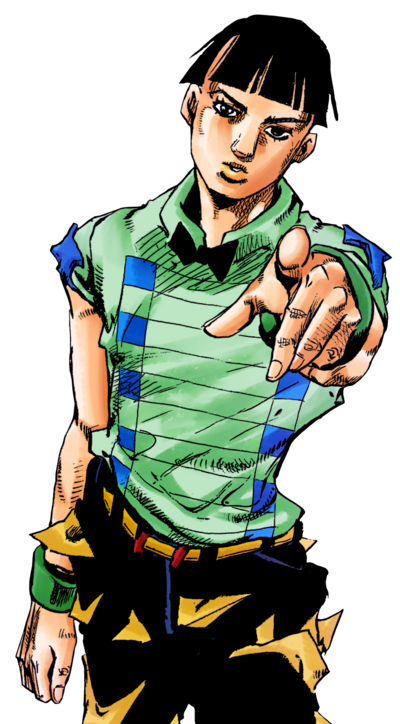
i so rarely hate characters, even ones that are meant to be disliked, because i usually appreciate their presence in the story and how fun it is to dislike them, but joshu.... joshu is another story entirely. so uh, challenge mode, here we go:
i think nut king call genuinely has a really interesting power and design
the way he's written makes it really clear just how much of him being Like That is a result of his messy family situation and intergenerational trauma, and i really appreciate the nuance to show that sometimes well-intentioned families can fuck their kids up
[PART 8 SPOILER] giving yasuho his arm was nice i guess, shame about the Entire Rest of that scene
#to me his crime is worse than just Being Unlikeable:#his crime is that i Don't Want To Read About Him#and therefore every minute he spends on screen is agonizing time i could be spending with any of the other far more fun characters#he commits the sin of Being A Bad Character In A Structural Sense#which is 10x worse than any morally reprehensible actions#like shut up joshu the adults are talking and im trying to follow the plot#you have nothing to contribute#go away#literally the ONLY character i can think of that i've Hated in a long time#anyways i tried very hard to be nice#like i Understand why he's like that and i think it's a well written choice#it's very clear araki knew what he was doing and both wrote him to be unlikeable On Purpose#and also showed that he's the result of the whole mess of his family situation#so he's not entirely unsympathetic#just. ugh.
8 notes
·
View notes
Text
Interview with Noda Satoru from the Golden Kamuy fanbook
sharing anywhere is fine, but please credit me.
Q: Tell me how you feel about passing 6 years of serialization. Noda: I was already serializing at the time of my debut, so I guess I’d be able to give a summary when I’m finished. I don’t really think about how many years it’s been, it’s merely a checkpoint.
Q: What made you decide to become a mangaka? Noda: I feel like I wrote it down as my goal in my yearbook back in middle school. I also wanted to become a movie director, but as a mangaka you can create the entire thing by yourself.
When Golden Kamuy just took off I was living in a tiny apartment and the postman, a young fellow and a reader of Young Jump, realized that I’m Noda Satoru. The magazine was sending me a lot of things, so it was rather obvious. “Are you the author of Golden Kamuy?”, he asked in a surprised tone while looking around the cramped entryway. I could feel feel his confusion regarding the fact that that vast Hokkaido world of the manga was being created in this modest apartment. Or maybe he just expected me to be making more money and afford a better place. Anyhow, I just thought again about how a manga can be created in even the smallest room in the universe.
Q: Who is your favorite character and why? Noda: As always, it’s Tanigaki. But well, I love all of them. I want to showcase only the best parts of them, and it hurts when I fail. For example I’m very happy that there’s a character who stirs the pot as well as Usami. He’d be Katsuo in the world of Sazae-san.
Q: Which characters are the easiest to draw, and which ones are the most difficult? Noda: Characters like Shiraishi, Tsukishima and Nagakura, they don’t have a lot of hair and even if they turn out a little ugly their faces are well-defined so it’s easy to draw. In general faces that are strongly distorted and resemble caricatures are easy. Meanwhile Asirpa, Kiroranke and Inkarmat have neat facial structures on top of wearing Ainu clothing, so they are a very high-calorie effort for me. Ogata and Kikuta are difficult too. Their faces are distinctive and I have to make them look cool too, which is wearing me out the most.
Q: Have you decided on all 24 convicts at the very start of the story? Noda: Wouldn’t I sound like a badass if I said that that I have? Anyway. There were the ones that were based off real-life Meiji era criminals, such as Shiraishi, Kumagishi Chouan or the lightning couple, and of course there was Hijikata.
Q: Tell me of a funny thing from the manga that you are fond of. Noda: Gansoku’s “Hah! ☆”. And also when Koito Jr. Was flapping his arms and legs around trying to keep himself in mid-air.
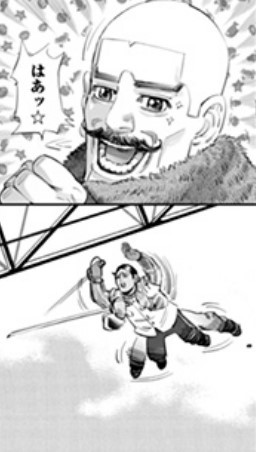
Q: Why did you decide on Otaru as the starting point? Noda: I am from Hokkaido, so I’m familiar with Otaru and Sapporo. Otaru is close to both the mountains and the sea. Sapporo used to be a swampland, it’s wide and flat and there is no sea. Otaru is a place where foreigners come and go, there are many criminals roaming around creating danger, and money is found. There aren’t many big cities in Hokkaido. There were Ainu living in Otaru but sources are scarce, however Nakagawa-sensei, the supervisor over the Ainu language, told me not to worry too much about the difference of location, so I figured it would be best to make it Otaru.
Q: Was there any real life experience you had while growing up in Hokkaido that you turned into a scenario? Noda: When I was about 19 someone I knew told me that there is a locust graveyard on a nearby mountain, which sounded so ridiculous I had to laugh in their face. Turns out it indeed was a heap of locusts and their eggs left after a locust plague, that place was the Teineyamaguchi locust mound (a real historical site). I realized I ended up using this in my story. I owe that person an apology.
Q: Was there any scene that was particularly difficult to draw? Could you elaborate on it? Noda: The time Sugimoto went against Nihei and Tanigaki. It gave me a very hard time. Who goes where and does what, how does Nihei carry Asirpa, stuff like this. I had no time to waste either, I just remember that sequence overall driving me insane.
There was also the sequence with Wilk, Sofia and Kiroranke being at Hasegawa’s photo studio. It’s really frustrating to draw something that you know will bore the readers, the story flow becomes less exciting too. I was praying for everyone to have a little more patience and keep reading, because the twist was so good.
Q: If you were to take part in the gold hunt, which group would you like to belong to? Noda: It seems that Hijikata’s group doesn’t have funding problems, and because Kadokura is there the atmosphere is relaxed too. I’d go there.
Q: If you were to find all that gold, how would you use it? Noda: No idea. Had a couple when I was younger, though.
Q: Were you planning to eventually transfer the action to Sakhalin from the very beginning of the series? Noda: Asirpa and Kiroranke have roots there, so I anticipated that the story will eventually move to Sakhalin. I also expected to have to travel to Amur river myself, but couldn’t go after all, only went as far as Khabarovsk.
I was thinking of making Sugimoto eat permafrost mammoth. There was talk of a research team or an ivory excavation team’s dog eating mammoth. However there was no reason to make Sugimoto and Co go as up north as needed for permafrost, so I scrapped the idea.
Q: Tell me something about the hardships you experienced while doing research is Sakhalin. Noda: It was tough, but fun. I was only able to understand the clear differences between Nivkh and Orok people by going there; I couldn't by only looking at records and materials while in Japan.
Complete unrelated, but I was surprised by how many stray dogs wander around there. One time my cameraman and I ended up being chased by one while looking for a factory and we had to run for it. The beast was big, about the size of a German Shepherd. The guide also warned us about junkies, it was really scary.
I also went to the Japanese military pillbox over 50th parallel north and prayed at a cenotaph deep in the mountains. I met a group of Japanese people in the hotel by the place where it's said you can still find remains of Japanese soldiers and their driver, a Russian, seemed to help with collection of the remains on the regular. He said that he's doing it out of reverence, even as a former enemy. As a Japanese, I felt gratitude. The 7th Division are villains in my story, but I don't have any personal bias against either side.
Q: What were the biggest differences between drawing Hokkaido and Sakhalin? Noda: Well... it's Russia. Even though Sakhalin is so close, it's already Europe. The structure of houses is strikingly different. There's also the differences between Hokkaido Ainu and Sakhalin Ainu, and differences between Orok and Nivkh people. There is no manga that will conveniently lay the differences of those down for you.
It seems that the Orok and Nivkh's relation with Japan only got more difficult by the beginning of Showa era, there is only one person in the whole of Japan who can supervise on the Orok language. The professors in cultural studies I consult for Golden Kamuy are truly top-level; not only are they tremendously knowledgeable, they also understand how important to me is to stay impartial.
The wildlife, as well. There's a biogeographical boundary between Hokkaido and Sakhalin, observing animals I would never be able to see in Hokkaido was riveting.
Q: Did Sugimoto really have a hidden plan during the whole stenka business? Noda: No idea. Even if he used it as a pretext to get everyone involved, though... cut him some slack. He's only a man. Sometimes he just wants to fight and win. Not for Ume-chan or Asirpa-san, just for the sake of proving to himself that he's strong.
Q: Your art is dynamic and detailed. I think your style changed quite a bit with time, though. How would you describe yourself as an artist? Noda: I want to preface this by saying that in no way do I think of myself as more skilled than other mangaka, but if you're drawing everyday for more than 10 hours you're going to improve a lot eventually, whether you want it or not. People who are able to keep the same style for years without change are the ones who are impressive, because it means that they achieved the peak of their potential. Ageing and health problems influence your art a lot, you know. I try to draw by observing. I use a lot of references. Drawing by memory alone is not a good thing.
Speaking of other artists, I once had one of the assistants I had working for me for years draw me a door knob from memory, and the result was a truncated cone resembling pre-packaged pudding. The actual shape of a door knob has an intricately angular circular shape. It's the result of being unobservant in everyday life. Good art requires constant observation.
Q: What was the foundation for your style? Is there an artist you were influenced or inspired by? Noda: Araki Hirohiko-sensei, for sure. During my time as an assistant, many authors told me to not even try to be original when it comes to battle abilities, it's already been done in JoJo, it has it all. He's kind of the Beatles of this industry, isn't he?
By the way, I usually have no intention of parodying JoJo in Golden Kamuy, but my friends will tell me that they identified this or that reference from time to time. I read Part 1 about 30 years ago but I was obsessed, so maybe some things were just left in my subconscious. I only did one obvious parody, during the stenka fight. Funnily enough that trope started in Fist of the North Star, though, not JoJo.
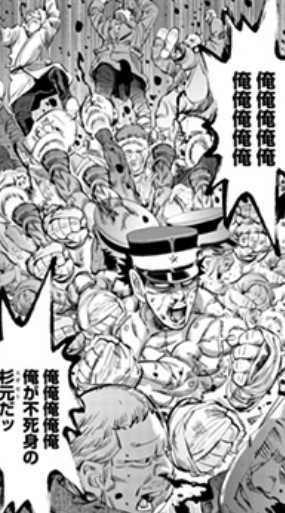
Q: What's one thing that gives you the most motivation to write? Noda: Fan letters. I know how straining it is to write long and neat sentences by hand, and am thankful for them. I'm happy that people go that far to share their thoughts about my work with me. I'm really grateful to the people who keep reading and supporting Golden Kamuy.
Q: Did you have an interest in Ainu culture before starting the series? Noda: I did not. I'll be glad if my work makes people interested in the Ainu. Prejudice is born out of ignorance, so if you want to learn about the Ainu, don't limit yourself to Hokkaido only; there are museums all around Japan, and they have knowledgeable curators. It's important to remember to take into account the time period and the occupation of the person on which the research materials are based when you're trying to learn about the subject.
Q: You showed us a lot of aspects of life during Meiji and Taisho eras. Tell us about what surprised or impressed you in the process of research. Noda: It's not that I was particularly knowledgeable, so having to check every single thing was quite exhausting. The Ainu, the military, katanas - all of these needed research on my part.
There are more regulations and rules set for things out there than one could assume, and mangaka who base their works on real life need to be especially careful about this. You have to take into account things like the size of the buttons on a military uniform, how a tea cup is held, and and how different people talk in different ways. For movies there's staff working on costumes and props, there's the cast, there are screenwriters, but in a manga you are the one responsible for every single detail. I wish I had a time machine and travel back to those eras. There are things I couldn't get right here and there that I keep having regrets about.
Q: Golden Kamuy was the main visual in the British Museum manga exhibition between May and August in 2019. I know you went there in person. How was it? Noda: The trip felt like a reward for all of my efforts. The exhibition is jam-packed by opening time, but I got special treatment and they let me inside early in the morning so I could walk around the vast British Museum in solitude. I also travelled between Jack the Ripper's crime scenes at night by taxi.
The driver in a taxi I caught by chance was wonderful, she looked up photos of the crime scenes and surroundings taken at the time of investigation on her smartphone and showed them to me one by one, saying things like "the third victim was found here!".
I've always had a soft spot for Jack the Ripper, back in middle school I even wrote a screenplay for a school festival stage and played him in it myself. It was done in very poor taste, like that one scene in the Addams Family movie where there are arms blown away and fountains of blood gushing out. The audience loved it.
Q: Please leave a message for the readers. Or maybe some advice for the troubled youth. Noda: I want people to say that everyone in Golden Kamuy had a satisfying ending, and I want that for everyone involved more than anything. As for advice for the troubled youth, there's none. Life is survival of the fittest. The weak ones get eaten.
249 notes
·
View notes
Photo
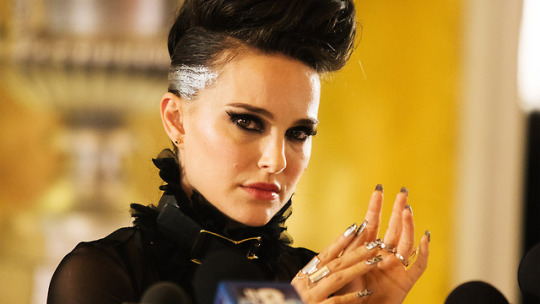
Pop star.
Dominic Corry heads to the AFI Fest screening of Natalie Portman’s new film Vox Lux, then hears what the Oscar winner has to say about it.
In Vox Lux, late 2018’s other pop star drama, Natalie Portman gives one of her rawest ever performances as Celeste, a global superstar about to embark on a huge tour. Even among fictional singers, Celeste has a unique backstory.
The first third or so of the film chronicles how a young Celeste (played by English actress Raffey Cassidy from Tomorrowland and The Killing of a Sacred Deer) barely survives a high school mass shooting. At a memorial for her fallen friends, she performs a song with her sister, and it goes viral. A manager (played by Jude Law) takes notice, and Celeste is on her way to Taylor Swift levels of idolatry.
The film then jumps ahead two decades to 2018, with Celeste now played by Natalie Portman. In a high-concept casting gambit that ends up working extremely well, her teenage daughter Albertine is also played by Cassidy.
Like in A Star Is Born, there is a resentment-laden relationship with a talented older sibling, Celeste’s sister Eleanor, played in both time periods by the ethereally ageless Stacy Martin (Nymphomaniac).
But ultimately Vox Lux treads a very different path to Bradley Cooper’s smash hit. This is an intensely intimate film that culminates with a spectacular meltdown and an arena-worthy pop star performance from Portman, who absolutely kills it performing songs written by prolific pop music genius Sia. It’s rare that “fictional” hits sound so convincing.
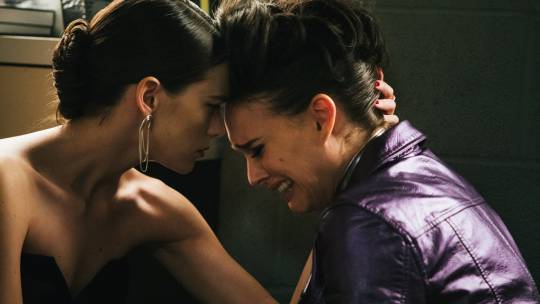
Raffey Cassidy and Natalie Portman in Brady Corbet’s ‘Vox Lux’.
Vox Lux was written and directed by Brady Corbet, who first came to prominence as an actor in films such as Gregg Araki’s Mysterious Skin (2004) and Michael Haneke’s 2007 remake of his own Funny Games. Vox Lux is Corbet’s second film behind the camera, following the 2015 period drama The Childhood of a Leader.
With Vox Lux, he ties tragedy and celebrity together in a thorny character study.
Following a recent screening of the film in Los Angeles, Portman got on stage to discuss making Vox Lux. Here’s some of what she had to say:
On what drew her to the role: Natalie Portman: It was an incredible opportunity to play a character that I’d never had the chance to play before. And also to work with someone like Brady who I think is incredibly talented and interesting and full of great ideas. And then also, I think a lot of the themes are really relevant to the world we live in. It feels like a really accurate portrayal of what it’s like to live in this moment in history, which feels very specific in a way that I hadn’t seen reflected before.
On how she approached the character: The biggest part of the character was the writing. Brady wrote such a specific character that felt so rounded and just like a real human being. Sometimes she’s really authentic and sometimes she’s totally fake. Sometimes she’s cruel and sometimes she’s gentle. And sometimes she’s performing and sometimes she’s being. It was really just remarkable reading it. So I feel like that really provided a great blueprint.
On whether or not she discussed how to approach Celeste with Raffey Cassidy, who plays the younger Celeste: We actually didn’t and I think that was intentional for Brady because he really wanted them to be different characters. Because she’s really changed obviously from this innocent young woman at the beginning and then we catch her after twenty years of hard life and I loved the fact that he chose to skip that period because we all know how to fill it in, we know plenty of, you know, the hard times of a pop star, the rocky road until their resurrection, it’s such a familiar tale to us so we don’t have to see it.
On working alongside Cassidy, who also plays her daughter, Albertine: Raffey’s remarkable. We didn’t rehearse together, we just started working together. The first time I saw her as young Celeste was when I saw the finished film, so to see how she could modify her performance so subtly [as Albertine] and really be believable as two completely different characters. I really thought Brady was nuts, I was like, “Are you sure? You’re gonna make me stand next to the actor that played me in the beginning and try to make people believe that we’re the same character?” But Brady was really convinced about it, and I think it’s so powerful in the film. I think we still often see our kids as versions of ourselves, and how we relate to them with all the self-hatred and self-love, alternately, or sometimes all at once. And then I think it’s just so powerful to have it embodied, the entire time she’s with her daughter, she’s also with her younger self. Both as what that means for everyone experiencing parenthood, but also for the film to see both of these versions of this woman together. I think it works because it’s like a metaphor but it also works literally. She does such a great job of acting. You do always believe that both characters are different people, but she holds within her both characters, so there’s like a doubling of meaning all the time.
On working with Jude Law again: Jude is just one of the greatest actors. His voice in this is different than I’ve ever heard. It has such amazing resonance. He is again also one of the kindest most wonderful people I know, a real major talent. It was very lucky ’cause this is the fourth film I’ve been in with him. We worked together for the first time on Cold Mountain almost twenty years ago, and then Closer, and we both were in the Wong Kar-Wai film My Blueberry Nights, [but] we didn’t have scenes together. So I’ve known him over the course of like, twenty years. We’ve never been like buddies or hanging out or anything, but I’ve worked with him and so it was lucky going into this that we had a history and comfort level to play off of, so like day one, I already felt at ease.

On performing songs written by Sia: It was incredible when I received the script to have the Sia songs with it, I remember getting an email with these attachments of the songs, and she sings them herself on the demos so of course they’re just gorgeous. Beautiful, beautiful songs, really great pop songs so I knew that it was realistic, because if you read a script and it says “and then she writes a hit pop song” and you don’t see the song, you’re like: okay good luck getting that. But it was clear from the beginning that it had this incredible music. And then getting to record it was really fun, because I got to work with [longtime Sia collaborator] Chris [Briade] who’s incredible and just the loveliest person. To see what they can do, they’re the real artists, they can do so much magic to make things sound like what we’re used to hearing.
On how she prepped for the lengthy song and dance performance finalé: Physically it was a lot of preparation, I worked with [movement coach] Raquel [Horsford], I worked with my husband on the choreography, across like a month. I actually prepped the film twice, because the night before, I think I was on my way to the airport, the first time, and they were like, “Turn home, the financing has come apart”. The movie was cancelled and I had prepped everything. When everything got pulled back together again it was a few months later, even though of course it was relatively recent in my memory, I had to kind of start over. So that was kind of nice because it gave me a longer time to prep, and a longer time to sit in my head and my body and all that.
So physically, it was dance training, physical training to have this endurance, and then emotionally I kept asking Brady if I should be kind of ‘off’. She’s had this massive breakdown, she’s had this drug experience, and he was like, “No, she’s out of it but she’s a professional, and she’s done this a million times…”.
She can handle it to the point where the audience isn’t aware that she had a drug-fuelled meltdown minutes earlier. So that was really informative in terms of the headspace, that she can kind of enter a space and leave everything behind her. Which is an interesting key to the character too because there’s a certain kind of erasure that I think must have to happen.
‘Vox Lux’ is in US theaters now.
7 notes
·
View notes